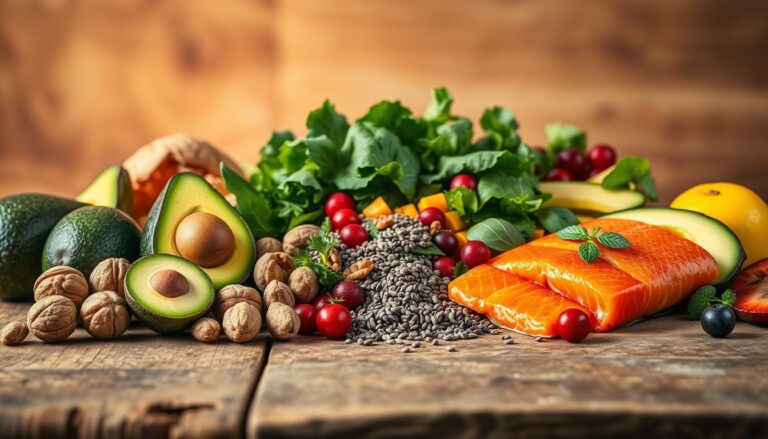Chronic pain affects millions worldwide. The need for safe and effective pain relief is urgent. Traditional medicines can help but often have side effects. What if we could use our body’s own pain relief?
Enter the world of natural painkillers. Here, plant-based options and our body’s own opioids offer a gentler yet powerful way to manage pain. Have you thought about using these natural remedies for your pain?
Key Takeaways
- Natural painkillers are plant-based or endogenous compounds that can help alleviate pain without the side effects of traditional pharmaceuticals.
- Endorphins, the body’s natural opioids, play a crucial role in pain relief by activating the mu-opioid receptor and reducing pain perception.
- Botanical extracts like Devil’s claw, capsaicin, and white willow bark are examples of plant-based analgesics that can provide relief for conditions like back pain, arthritis, and headaches.
- Researchers are exploring ways to enhance the body’s natural pain-relieving mechanisms, such as through positive allosteric modulators that boost the activity of endogenous opioids.
- Holistic approaches to pain management, including the use of natural painkillers, can offer a complementary solution to traditional pain relief methods.
What are Natural Painkillers?
Natural painkillers come from plants and can help with pain. They offer a different way to manage pain, often with fewer side effects than medicines.
Understanding the Role of Endorphins
Endorphins are hormones that help with pain and mood. They work with the brain to reduce pain. Things like exercise and laughter can make endorphins, helping with pain naturally.
Plant-Based Pain Relief Alternatives
There are also plant-based options for pain relief. These botanical pain relievers and herbal analgesics include compounds from plants like turmeric and cloves. Plant-based anti-inflammatories like Boswellia help with pain, especially in osteoarthritis.
More people are using natural painkillers for pain management. While they might not work for everyone, they offer a natural choice for those looking to avoid medicines.

“Natural remedies can be a valuable complement to conventional pain management approaches, providing relief with potentially fewer side effects.” – Dr. Sarah Thompson, Pain Specialist
Harnessing the Power of Endorphins
Endorphins are our body’s natural painkillers. They can be triggered through different activities and techniques. By using endorphins, we can get natural pain relief, feel less stressed, and boost our mood.
There are over 20 types of endorphins in our bodies. Beta-endorphins are most linked to natural pain relief and stress reduction. When endorphins meet brain cells, they create a short, happy feeling. This feeling can block pain, like a runner’s high.
Many studies show the good effects of endorphin release on our well-being. For example, students with positive feelings do much better in school. Happy employees are also 12% more productive.
Boosting Endorphin Levels through Lifestyle Choices
Here are some ways to increase endorphin release:
- Exercise, like walking or swimming, boosts endorphins. Group workouts can even improve mental health by 13%.
- Eating dark chocolate with at least 70% cocoa can also increase endorphins. It helps with emotional well-being.
- Listening to music can release endorphins and dopamine. This improves mood and focus while studying.
- Laughter releases endorphins, lowers stress, and boosts mood, blood pressure, and immune system.
- Volunteering and being kind can also release endorphins. It rewards kindness and may lower the risk of hypertension.
By adding these endorphin-boosting activities to our daily lives, we can use our body’s natural painkillers. This leads to natural pain relief, stress reduction, and mood enhancement.

| Benefit | Impact |
|---|---|
| Improved Cognitive Performance | Exercise improves concentration, memory, and motivation. It boosts cognitive performance. |
| Increased Self-Esteem | Regular exercise can increase self-esteem. It leads to a greater sense of self-worth and confidence. |
| Enhanced Resilience | Regular exercise builds resilience. It helps individuals cope with life’s challenges, fostering inner strength and determination. |
“The release of endorphins during exercise acts as natural painkillers and mood elevators. They combat symptoms of depression and anxiety.”
Nonsteroidal Anti-Inflammatory Drugs (NSAIDs)
NSAIDs are a common pain medication. They block prostaglandins, which cause pain and inflammation. These drugs are available over-the-counter and help with mild aches and pains.
How NSAIDs Work for Pain Relief
NSAIDs reduce prostaglandins, which signal pain and inflammation. By blocking enzymes, they decrease swelling and pain perception.
Benefits and Risks of NSAIDs
NSAIDs offer pain relief but also have risks. They can reduce inflammation and lower heart attack and stroke risks. They help with headaches, sprains, and arthritis symptoms.
However, they can cause stomach problems and heart issues. Risks include stomach ulcers, bleeding, high blood pressure, and heart problems.
People over 60, pregnant women, and those with certain conditions should be cautious. Excessive use can lead to heart problems and stroke.
| Benefits of NSAIDs | Risks of NSAIDs |
|---|---|
|
|
It’s crucial to use NSAIDs responsibly. Always follow a doctor’s advice, especially if you have health issues. This way, you can enjoy their benefits while avoiding risks.

Acetaminophen: A Safer Option?
Acetaminophen, known as Tylenol, is seen as safer than NSAIDs like ibuprofen for pain relief. It doesn’t target inflammation like NSAIDs do. Instead, it blocks prostaglandins in the brain, offering pain relief without stomach or heart risks.
But, acetaminophen isn’t risk-free. Taking too much can harm the liver, especially with alcohol. In the U.S., it’s a top cause of liver failure.
Still, many people choose acetaminophen for pain relief. Demand for over-the-counter pain relievers is on the rise. It’s seen as safer than NSAIDs, especially for those with certain health issues.
| Medication | Mechanism of Action | Potential Benefits | Potential Risks |
|---|---|---|---|
| Acetaminophen | Blocks prostaglandin production in the central nervous system | Generally considered safer than NSAIDs for pain relief | Liver damage, particularly when combined with alcohol |
| NSAIDs (e.g., ibuprofen) | Targets inflammation directly | Effective for reducing inflammation and pain | Increased risk of stomach ulcers, cardiovascular issues |
Choosing between acetaminophen and NSAIDs should be a doctor’s decision. It depends on your health, the pain type, and the risks and benefits of each.

COX-2 Inhibitors: Selective Anti-Inflammatory Agents
COX-2 inhibitors are a special type of drug that targets the COX-2 enzyme. This enzyme is key in causing pain and inflammation. These drugs aim to reduce stomach problems by keeping the COX-1 enzyme safe.
The Mechanism of COX-2 Inhibitors
COX-2 inhibitors block the COX-2 enzyme, which causes pain and inflammation. They do this without harming the COX-1 enzyme, which protects the stomach. This way, they offer pain relief and reduce inflammation, possibly with fewer stomach side effects.
Celecoxib (Celebrex®) is the only COX-2 inhibitor available in the U.S. Etoricoxib (Arcoxia®) and Parecoxib (Dynastat®) are used in other countries. But, drugs like Rofecoxib (Vioxx®) and Valdecoxib (Bextra®) were taken off the market because of heart risks.
Even though COX-2 inhibitors might be safer for the stomach, they can still pose risks. They might increase the chance of heart problems, especially with long-term use or high doses. It’s vital to have regular check-ups and monitoring when using these drugs.
“COX-2 inhibitors must be taken for a short-term for pain relief, usually for days to a couple of weeks, at the lowest possible dose.”
In summary, COX-2 inhibitors offer a targeted approach to pain and inflammation. They might lower the risk of stomach problems seen with other NSAIDs. But, it’s essential to use these drugs carefully and under the guidance of a healthcare provider, due to potential heart risks.
Antidepressants and Anti-Seizure Medications for Pain Management
Some medications for depression and epilepsy also help with chronic pain. This includes nerve pain from diabetes, fibromyalgia, and shingles. These drugs change how our nervous system handles pain signals.
Tricyclic antidepressants, like amitriptyline and nortriptyline, treat chronic pain. They work by blocking certain chemicals in our brain. This can make pain feel less intense. But, they can also cause side effects like dry mouth and drowsiness.
Anti-seizure drugs, like gabapentin and pregabalin, also help with nerve pain and fibromyalgia. They affect specific parts of our nervous system. This can help reduce chronic pain. Though, they might make you feel dizzy or gain weight.
People with chronic pain should talk to their doctors about these medications. Together, they can find the best treatment. This might include antidepressants or anti-seizure drugs as part of a pain management plan.

These medications work in different ways but are effective for chronic pain. They target the brain’s pain processing. This offers a new way to manage pain, alongside traditional treatments.
The Role of Opioids in Chronic Pain Relief
Opioid medications, like hydrocodone and oxycodone, are strong pain relievers. They work by mimicking the body’s natural pain fighters, endorphins. But, using them for long periods can lead to addiction and tolerance.
Understanding Opioid Tolerance and Addiction
Opioids can make users feel good, which increases the risk of addiction. Using them in ways not meant by doctors, like swallowing or injecting, can lead to serious health issues. As addiction grows, it can damage relationships and even lead to job loss.
Recent studies show opioids can actually make chronic pain worse. Short morphine treatments heightened and prolonged pain in rats with nerve injuries, and injured rats treated with morphine were sensitive for longer durations and to a higher degree compared to saline-treated animals. This effect was not due to opioid receptors but to inflammation. Blocking inflammation can prevent this prolonged pain without losing the pain relief benefits.
“About 75% of people in the U.S. who became addicted to street opioids such as heroin during the 2000s report that they started out taking prescription opioid drugs.”
The dangers of opioid use, like addiction and overdose, are increasing. Opioid overdose deaths are rising in the United States, and the risk of respiratory depression or respiratory arrest is higher in individuals taking an opioid drug for the first time, those on interacting medications, or people with conditions affecting their breathing. It’s important to understand these risks when thinking about using opioids for pain.
Positive Allosteric Modulators: Enhancing Natural Pain Relief
Scientists are looking into positive allosteric modulators (PAMs) to boost our body’s natural pain relief. PAMs make our endogenous opioids, like endorphins and enkephalins, work better. This is without the risks of addiction and side effects seen with man-made opioids.
Research shows PAMs of the mu-opioid receptor (MOR) can make endogenous opioids more potent. For instance, BMS-986122 makes DAMGO and Methionine-enkephalin (Met-Enk) 6.6 and 10 times stronger in the brain’s PAG region.
BMS-986122 also boosts the effects of synthetic opioids like morphine and methadone. It makes them 4.8 and 8 times stronger. This could mean PAMs could help reduce opioid side effects and addiction risks.
Oxytocin (OT) is another natural PAM. It acts on both MOR and KOR, helping our body’s natural pain relief.
Creating PAMs that target specific opioid receptors is promising for pain management. They could offer effective pain relief with fewer side effects and addiction risks than traditional opioids.
Natural Anti-Inflammatory Supplements
There are natural anti-inflammatory supplements made from plants that can help with pain. These plant extracts have shown they can reduce pain and inflammation. They offer a natural alternative to traditional medicines.
Curcumin and Other Botanical Extracts
Curcumin, found in turmeric, is well-studied for its anti-inflammatory and pain-relieving effects. It’s often used to help with arthritis, muscle soreness, and chronic pain.
Other plant extracts like white willow bark, boswellia, and ginger also help reduce inflammation and pain. They can be used alone or with other treatments to manage pain better.
| Natural Anti-Inflammatory Supplement | Key Findings |
|---|---|
| Curcumin | – Effective in reducing inflammation and pain in conditions like arthritis, muscle soreness, and chronic pain – Exhibits anti-inflammatory and analgesic properties |
| White Willow Bark | – Contains salicin, a natural compound similar to aspirin – Demonstrated efficacy in relieving low back pain and osteoarthritis |
| Boswellia | – Exhibits anti-inflammatory and pain-relieving effects – May be beneficial for conditions like osteoarthritis and rheumatoid arthritis |
| Ginger | – Possesses anti-inflammatory and analgesic properties – Can be helpful in managing muscle soreness and joint pain |
These natural anti-inflammatory supplements from botanical extracts are a safe and effective way to manage pain relief. They are a good alternative to some pharmaceutical options. Always talk to a healthcare professional before adding them to your pain management plan.
Holistic Approaches to Pain Management
Managing chronic pain can be done in many ways. It’s not just about medication. Integrative medicine and lifestyle changes can help tackle pain from different angles.
Mind-body practices are key in holistic pain management. Meditation, yoga, and acupuncture can lower pain and boost life quality. They focus on the mind-body connection to tackle pain’s physical and emotional sides.
Changing your lifestyle is also important. Regular exercise, managing stress, and eating right can help with pain. For example, vitamins B, C, D, and antioxidants support nerve health and fight inflammation.
Natural remedies like aloe vera gel can also help with pain. Companies like AloeVeritas work with PainSmarts to study these natural solutions.
Embracing a holistic approach helps those with chronic pain find a better treatment plan. This method aims to fix pain’s root causes, improve overall health, and empower patients to heal themselves.
| Holistic Pain Management Techniques | Benefits |
|---|---|
| Meditation and Mindfulness | Reduces stress and muscle tension, leading to lower pain levels |
| Yoga and Acupuncture | Targets the mind-body connection, alleviating both physical and emotional aspects of pain |
| Therapeutic Massage | Beneficial for various chronic pain conditions |
| Nutritional Supplements | Supports nerve health and reduces inflammation for pain relief |
| Aloe Vera | Provides anti-inflammatory and analgesic properties for muscle and tendon pain |
By taking a holistic approach, people can find a more effective way to manage pain. Integrative medicine and lifestyle changes offer a path to better pain relief and overall well-being.
“Chronic pain is a complex issue that requires a multifaceted approach. Integrating mind-body techniques, lifestyle changes, and natural remedies can be a powerful way to address the root causes of pain and improve quality of life.”
Conclusion
Natural painkillers, like our body’s endorphins and plant-based options, are key in pain management. They help us understand how to relieve pain naturally. By mixing both medicine and holistic therapies, we can manage pain safely and improve our lives.
This article showed how natural painkillers like peppermint oil, turmeric, and Boswellia help with pain. These alternative therapies can work with or instead of regular pain meds. They offer a more complete way to handle pain.
As more people look for natural painkillers, it’s important for doctors and patients to keep up with new research. A balanced approach to pain management lets us control our health. It helps us find real solutions to our pain, not just cover it up.





